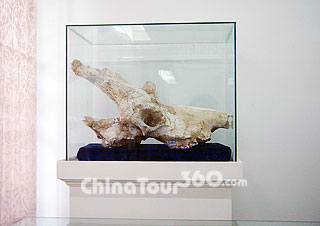 National Stone Museum
National Stone Museum
National Stone Museum
Next to the Guiyuan Buddhist Temple in the Cuiwei Road of the Hanyang District, the National Stone Museum of Wuhan City is a good place to appreciate the rare rocks and the exquisite bonsais. Occupying an area of about 6,700 square meters (1.7 acres) and a floor area of 2,500 square meters (0.6 acre), the museum is in the garden style of the Ming (1368 - 1644) and Qing (1644 - 1911) Dynasties which impress you as an ancient royal sense.
There are eight indoor exhibition halls displaying more than 3,000 samples of rocks of a wide variety of kinds. Fancy rocks such as chrysanthemum, Peony, Lingbi and crystal stones, fossils and many others will satisfy your curiosity. All the rare rocks have been collected from all over China, except for one piece that is said to be from Malaysia. The effort that has gone into collecting the rocks and stones ensure the museum has a wealth of fancy and valuable exhibits to challenge your view and imagination. Almost all existing types of rock can be found in the museum. The National Stone Museum has taken part in many studies in the rock-appreciation field at both home and abroad.
An outdoor garden displaying root carvings and bonsais next to the Muoshui Lake presents another perceptive view of nature. It also displays a harmony between water and stone. More than sixty bonsais dotted around mini scenic spots provide a background for relaxation and contemplation.
![]() Entrance Fee: CNY 20; CNY 10 for Students
Entrance Fee: CNY 20; CNY 10 for Students
![]() Bus Routes: Take Tourism Bus No. 401 and get off at Guiyuan Temple stop.
Bus Routes: Take Tourism Bus No. 401 and get off at Guiyuan Temple stop.
Yangtze River Bridge
The Yangtze River Bridge in Wuhan City was the Chinese People's first try to overcome the Yangtze River, thus connecting the south and the north bank.
The construction started on 1st September, 1955 and was completed on 13th October, 1957. The bridge spans over the Yangtze River with a total length of about 1,670 meters (5,479 feet). Eight piers in the water support the bridge and each two with a span of 128 meters (about 420 feet).
The bridge is double-layered. The top is highway which is 20 meters wide with four carriageways while the bottom is railway which is 14.5 meters with two tracks, allowing trains to pass through at the same time. The height beneath the bridge allows 10,000-ton ships to pass even at the highest water level.
The design of Yangtze River Bridge bears traditional Chinese characters. Patterns of animals and birds are engraved on the columns of both sides. A seven-tiered bridge tower is constructed at each end of the bridge, in which many earth sculptures of the contributors for the bridge are placed in the hall for commemorating their great deeds.
The Wuhan Yangtze River Bridge greatly improved the transportation of Wuhan city and accelerated the connection of northern and southern China.
![]() Transportation: Take Bus No. 1, 4, 10, 61, 64, 401, 402, 411, 413 or 584 and get off at Hanyang Qiaotou stop.
Transportation: Take Bus No. 1, 4, 10, 61, 64, 401, 402, 411, 413 or 584 and get off at Hanyang Qiaotou stop.
![]() Tip: A famous Lane named Hubu Lane is just located at one end of the bridge. The Lane is famous for many delicious local snacks, such as WuHan Hot Noodles with Sesame Paste, Chen Family Beef Noodles, the Gao Family Porridge and the Wan Family Rice Wine.
Tip: A famous Lane named Hubu Lane is just located at one end of the bridge. The Lane is famous for many delicious local snacks, such as WuHan Hot Noodles with Sesame Paste, Chen Family Beef Noodles, the Gao Family Porridge and the Wan Family Rice Wine.







